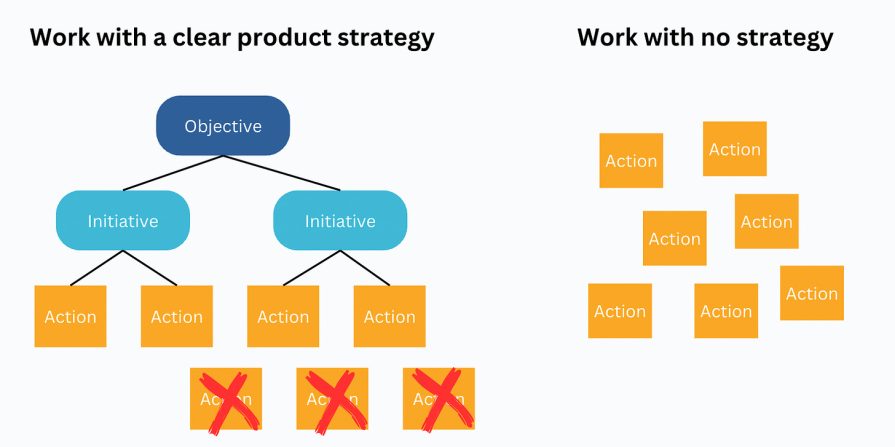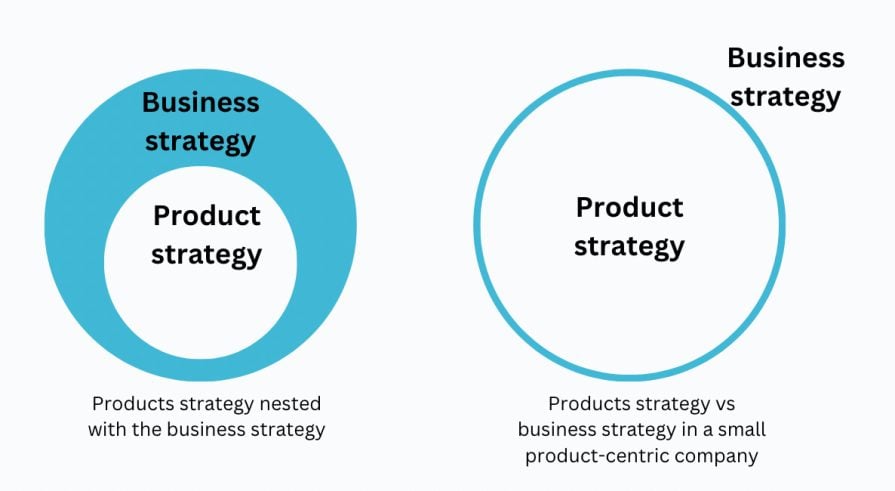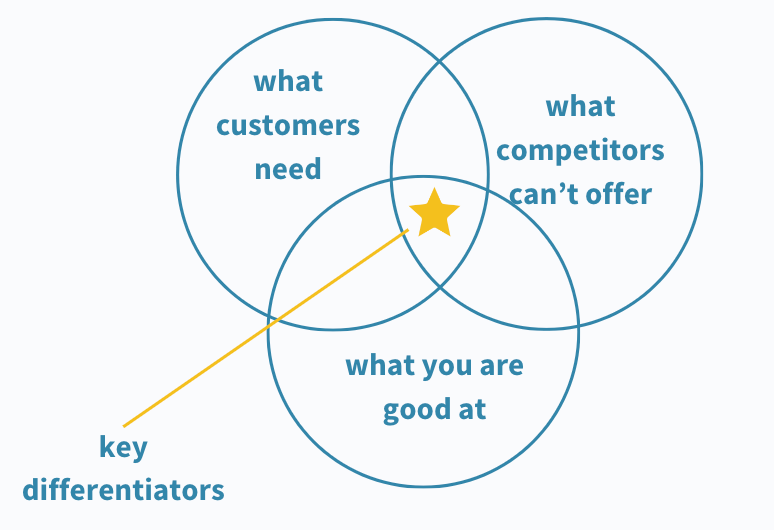As a product manager, it’s a good strategy to try periodically asking several individuals within your organization to share their key priorities. If you receive conflicting responses, it’s a strong indicator that you lack a clear strategy.

Day-to-day operations can be tricky. Requests flow in from customers, sales teams, and various stakeholders. Everyone has an idea or an exceptional pressing question that needs to be answered. This can make prioritization a real struggle.
In this article, you’ll learn what a product strategy is, how to create a successful one, and the principles that lead to success.
Product strategy is a simple system of goals that aligns teams toward desirable outcomes for both the business and the customers.
These goals provide teams with clear guidance on what is essential and help them prioritize activities effectively, including when to say no.
The primary aim of a product strategy is to connect teams and channel their efforts in a single direction. Organizations with a well-defined strategy have clarity on key focus areas and understand their importance. They know how to broadcast a clear strategic message to ensure that these priorities are widely embraced throughout the entire organization.
When everyone adopts these goals and incorporates them into their smaller vision, a shared vision emerges:

With a clear strategy, every team effort contributes to an important company objective. Without a strategy, teams engage in a multitude of actions without a clear understanding of the bigger goal, making prioritization an impossible task.
The distinction between product strategy and business strategy depends on the product’s scope relative to your entire organization.
The business or company strategy encompasses the overarching organizational goals and a high-level plan for achieving them. It spans all aspects of the business, including the product and service portfolio, marketing, operations, and more.
In contrast, product strategy is focused on a specific product or line of products. It must align with the broader business strategy, essentially nesting within it.
In the context of a small startup with a single product central to the entire business, the product strategy may also be identical to the business strategy:

A product strategy doesn’t need to be a complex 10-page document. It’s not an exhaustive list of solutions to be built in the upcoming year. Instead, it’s a straightforward, high-level plan outlining your key goals, what you’ll work on to achieve those goals, and why.
While the end result should appear simple, creating a successful and simple product strategy involves a more intricate thinking process. Let’s delve into the foundational aspects that contribute to a successful product strategy.
Starting from the basics, a clear vision and core values have a direct impact on your strategy. They serve as the foundation for an effective product strategy, providing guardrails and guiding decisions. The vision represents the highest-level idea of how you aim to improve your customer’s life or change the world.
For instance, Amazon’s vision is to be earth’s most customer-centric company, creating a space where people can discover anything they want to buy online. The core values, including customer obsession, passion for invention, commitment to operational excellence, and long-term thinking, further shape Amazon’s core principles.
These guiding principles make it evident that the company’s objectives should focus not on short-term business gains, but on long-term and enduring benefits for the customer.
A robust product strategy builds on a thorough understanding of the target market or niche. Before establishing any goals, you need to have a crystal-clear understanding of who the product is designed for. The aim isn’t to create a product for everyone but to tailor it for a specific audience with shared desires and needs.
Understanding the niche goes beyond geographical, age, gender, or professional considerations. What is often more important is understanding their beliefs, passions, aspirations, and the areas they aim to enhance in their lives. This helps grasp how the product facilitates users in transitioning to their desired state and what concrete benefits your product offers to the users.
Now that you know the needs and desires of your customers, should you aim to address all of them? Not quite. Rather than attempting to enhance every aspect of the product, a key element of the strategic framework involves honing in on the sweet spot.
Take, for instance, an e-commerce marketplace. Customer benefits might include the highest quality products, diversity of products, lowest prices, fastest delivery, optimal digital user experience, and top-notch customer service.
Striving to be the best in every category isn’t a sound strategy. While checking all the boxes is ideal, attempting to excel in all aspects simultaneously is risky. It’s more effective to identify the sweet spot — what niche customers truly need, what your competitors can’t provide, and where your strengths lie.
Understanding product differentiators means pinpointing the areas you want your product to be known for:

A solid product strategy rests on the foundation of vision, core values, user needs, and product differentiators. Once these essential elements are established, defining the objectives — integral components of the product strategy — flows naturally. Objectives serve as milestones on your path to achieving the vision, with core values and differentiators guiding and supporting the formulation of these objectives.
Product objectives are essentially derived from the broader company objectives, but offer a more concrete representation from a product standpoint.
Imagine a company operating an online shopping platform as its primary product. The overarching strategic objective for this year is to boost annual recurring revenue.
The product team has introduced a subscription model, anticipating it as a catalyst for achieving this goal. However, data analysis uncovers a notable trend — a substantial majority of users are inclined towards one-time purchases, with only a fraction embracing regular subscriptions.
After talking to users, a major issue surfaces: some products have a significantly slow delivery time. The overall delivery time guaranteed by the subscription model exceeds what users find acceptable.
The product goal becomes clear: reduce delivery times, aligning them with user preferences and expectations. To make this goal effective, it’s crucial to also establish metrics and monitor progress over time.
Every business and product has its own special traits and encounters unique challenges. Creating a product strategy is unique to each situation and you need to use your own judgment. However, there are basic principles that should guide how you define your product strategy.
A successful product strategy centers on selecting a few high-impact items that enhance both user satisfaction and contribute to your business success. Rather than attempting to do it all, prioritize wisely and make decisions based on key high-impact items. Ideally, these elements should be mutually reinforcing, working together to amplify the overall impact.
Top-notch product companies prioritize their customers, shaping the product vision around customer needs. They focus their goals on delivering customer value rather than solely pursuing financial gains.
For instance, a key product strategic goal could be to reduce delivery time for the customer. This objective doesn’t solely focus on the financial benefit for the company but emphasizes enhancing the customer experience.
A strong product strategy is simple — a straightforward and clear message that can be easily communicated across all teams.
Rather than relying on a lengthy and intricate document to explain every detail of the strategy, the power lies in selecting a high-impact goal and effectively spreading the message. The key is to have every team and every employee in the company embrace that goal as their own story.
The goals you prioritize should be grounded in data. For instance, if you aim to enhance delivery time, ensure it’s backed by concrete customer insights. Your data should reveal that delayed delivery is a significant obstacle for many users, impacting their trust and product selection.
Of course, solely relying on data isn’t the complete solution; you must also apply your own judgment. But ignoring data is akin to navigating blindly based on assumptions.
Creating a product strategy is not a one-and-done job, but an ongoing effort demanding continuous review and enhancement. Set up a systematic process to regularly evaluate and refine the strategy. Revisit it on a quarterly or yearly basis. Continuous improvement is crucial to ensuring the strategy remains relevant and effective as time goes on.
Crafting a robust product strategy is just the beginning of your product journey. Achieving success relies equally on effective execution. The crucial element lies in translating the strategy into actionable initiatives, seamlessly integrating it with the unique roadmaps of each team, and ultimately linking it to their daily activities.
In the wise words of Morris Chang:
Without strategy, execution is aimless. Without execution, strategy is useless.
Featured image source: IconScout

LogRocket identifies friction points in the user experience so you can make informed decisions about product and design changes that must happen to hit your goals.
With LogRocket, you can understand the scope of the issues affecting your product and prioritize the changes that need to be made. LogRocket simplifies workflows by allowing Engineering, Product, UX, and Design teams to work from the same data as you, eliminating any confusion about what needs to be done.
Get your teams on the same page — try LogRocket today.

A practical five minute revenue estimation method to help product managers compare ideas, drop low impact features, and prioritize smarter.

A practical guide for PMs who want to stop being bottlenecks, delegate smarter, and lead teams effectively with a clear ownership framework.

Stop letting unreliable data block features. Treat data as inventory to track quality, ownership, and ship with confidence.

Learn why slide decks slow teams down and explore better tools like whiteboards, PRDs, and prototypes to improve collaboration and alignment.